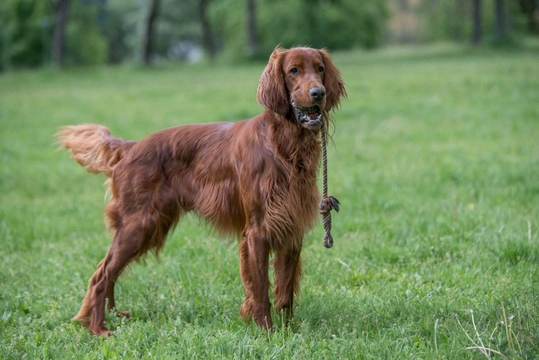
Globoid cell leukodystrophy or Krabbe disease DNA health testing for Irish setters
The Irish setter is a large, lean and very handsome-looking dog with a beautiful deep and glossy red coat, which most dog lovers can recognise instantly even though the breed isn’t one of the more common ones in the UK.
Irish setters were originally used for working roles as gun dogs, and as such are recognised for pedigree registration in the UK within the Kennel Club’s gundog group. However, dogs of the breed are much more commonly owned as pets than kept for working roles these days, and these large, rangy, outgoing and enthusiastic dogs can be very rewarding to own.
They are usually quite amenable to training and pick up new skills well, and they have very high energy levels, which means that they need to live an active life and spend plenty of time outside being walked and running around. They can be quite high maintenance on the grooming front in order to keep those bright glossy coats in good condition, and to keep shed hair from making a mess within the home.
The breed also tends to be quite long-lived for a large dog breed, with an average lifespan of around 10-15 years. That said, there are a number of hereditary health conditions that have been identified as being more prevalent within the Irish setter breed than others, and that are considered to pose a risk to the health of individual Irish setters, and the breed as a whole.
One of the hereditary health conditions Irish setters can suffer from is called globoid cell leukodystrophy (also known as Krabbe disease), and this is a type of systemic health condition that causes a wide range of neurological symptoms, and that cannot be treated or cured. Irish setter globoid cell leukodystrophy or Krabbe disease ultimately usually proves fatal for affected dogs, often before they even reach their first birthday.
There is a DNA testing scheme in place for Irish setters (and also for Cairn terriers and West Highland white terriers too) that can identify the markers of the condition in adult dogs before they are bred from, to allow breeders to make an informed choice about healthy mating matches.
In this article we will explain how Irish setters can inherit globoid cell leukodystrophy or Krabbe disease, how the condition affects dogs, and how to get your Irish setter tested for the markers of the condition. Read on to learn more about Irish setter Krabbe disease or globoid cell leukodystrophy.
What is globoid cell leukodystrophy or Krabbe disease in the Irish setter?
Globoid cell leukodystrophy and Krabbe disease are two different names for the same condition, and you might hear your vet use either one to describe it.
Globoid cell leukodystrophy is a type of lysosomal storage disease, which occurs due to a gene mutation that causes defects in the body’s ability to hydrolyse certain types of lipids that the body needs to maintain healthy myelin, which is a type of protective coating that sheaths the nerves.
This in turn leads to a wide range of neurological symptoms developing that are usually severe and acute, and that include seizures, blindness, poor muscle tone, and other problems too. Globoid cell leukodystrophy usually ultimately results in a premature death, sometimes before the dog reaches their first birthday. Few affected dogs make it to their second year of life, and the condition cannot be treated or cured.
Irish setters with globoid cell leukodystrophy usually appear to be perfectly healthy at birth, but the first symptoms of globoid cell leukodystrophy in Irish setters usually begin to develop early in life, generally between the ages of six and twenty-two weeks old.
How do Irish setters inherit globoid cell leukodystrophy?
Globoid cell leukodystrophy in Irish setters is hereditary, and whether or not any given dog inherits it depends on the status of both of their parents. This is because Irish setter globoid cell leukodystrophy is inherited by means of autosomal recessive heredity, which means that a gene mutation from both parents must be inherited for the condition to develop into the affected form in any given dog.
If you know the status of both parents of any given dog, or both of the parents of a prospective litter, you can work out whether or not the dog or litter in question will have the condition themselves.
Here’s how globoid cell leukodystrophy status is determined in Irish setters:
- Two affected parent dogs will have affected offspring.
- Two clear parent dogs will have clear offspring.
- Two carrier parent dogs will have offspring with odds of 50% to inherit carrier status, 25% to inherit clear status, and 25% to inherit affected status.
- A clear parent bred to a carrier parent will produce offspring with a 50% chance of being clear and a 50% chance of being affected.
- An affected parent bred to a carrier parent will produce offspring with a 50% chance of being affected and a 50% chance of being a carrier.
- A clear parent bred to an affected parent will produce a litter of carriers.
How to get an Irish setter DNA tested for globoid cell leukodystrophy
Because globoid cell leukodystrophy is a very serious condition, all Irish setter breeders are advised to get their parent stock tested prior to going ahead with a mating match.
To do this, you just need to ask your vet to take a DNA sample from the dog in question, which they will then send off to an approved laboratory who will test it and return the result to the dog’s owner.
Don’t forget that in order to determine the status of a litter, both parents need to be tested, and test results from just one dog in a mating match won’t determine the status of the litter.



